Spring Boot(二):数据库操作
本文主要讲解如何通过spring boot来访问数据库,本文会演示三种方式来访问数据库,第一种是JdbcTemplate,第二种是JPA,第三种是Mybatis。之前已经提到过,本系列会以一个博客系统作为讲解的基础,所以本文会讲解文章的存储和访问(但不包括文章的详情),因为最终的实现是通过MyBatis来完成的,所以,对于JdbcTemplate和JPA只做简单演示,MyBatis部分会完整实现对文章的增删改查。
一、准备工作
在演示这几种方式之前,需要先准备一些东西。第一个就是数据库,本系统是采用MySQL实现的,我们需要先创建一个student的表:
DROP TABLE IF EXISTS `student`;
CREATE TABLE `student` (
`id` varchar(10) NOT NULL,
`name` varchar(10) default NULL,
`age` varchar(10) default NULL,
`schoolName` varchar(55) default NULL,
`createTime` datetime default NULL,
PRIMARY KEY (`id`)
) ENGINE=InnoDB DEFAULT CHARSET=utf8;
后续的演示会对这个表进行增删改查。另外配置文件使用properties配置,即application.properties(你也可以使用application.yml配置文件,没什么太大的区别,如果对ymal不熟悉,有兴趣也可以查一下,比较简单)。
spring.datasource.url=jdbc:mysql://localhost:3306/databasezfy?useUnicode=true&characterEncoding=UTF-8&useSSL=false
spring.datasource.driverClassName=com.mysql.jdbc.Driver
spring.datasource.username=root
spring.datasource.password=123456
最后,我们还需要建立与数据库对应的POJO类,代码如下:
public class Student implements Serializable{
private static final long serialVersionUID = 5465872778586910807L;
private String id;
private String name;
private String age;
private String schoolName;
private Date createTime;
}
好了,需要准备的工作就这些,现在开始实现数据库的操作。
二、与JdbcTemplate集成
首先,我们先通过JdbcTemplate来访问数据库,这里只演示数据的插入,上一篇文章中我们已经提到过,Spring boot提供了许多的starter来支撑不同的功能,要支持JdbcTemplate我们需要引入下面的starter和连接mysql的驱动:
<dependency>
<groupId>org.springframework.boot</groupId>
<artifactId>spring-boot-starter-jdbc</artifactId>
</dependency> <dependency>
<groupId>mysql</groupId>
<artifactId>mysql-connector-java</artifactId>
<version>5.1.34</version>
</dependency>
现在我们就可以通过JdbcTemplate来实现数据的插入了:
public interface StudentDao {
int insertStudent(Student student);
}
@Repository
public class StudentDaoImpl implements StudentDao{ @Autowired
private NamedParameterJdbcTemplate jdbcTemplate; @Override
public int insertStudent(Student student) {
String sql = "insert into student (id,name,age,schoolName,createTime) values (:id,:name,:age,:schoolName,:createTime)";
Map map = new HashMap();
map.put("id",student.getId());
map.put("name",student.getName());
map.put("age",student.getAge());
map.put("schoolName",student.getSchoolName());
map.put("createTime",student.getCreateTime());
int result = jdbcTemplate.update(sql, map);
return result;
}
}
我们通过JUnit来测试上面的代码:
@RunWith(SpringJUnit4ClassRunner.class)
@SpringBootTest(classes = DemoApplication.class)
public class StudentDaoTest { @Autowired
private StudentDao studentDao; @Test
public void testInsert(){
Student student = new Student();
student.setId("1");
student.setName("zs");
student.setAge("10");
student.setSchoolName("一中");
student.setCreateTime(new Date());
studentDao.insertStudent(student);
} }
测试结果:test passed
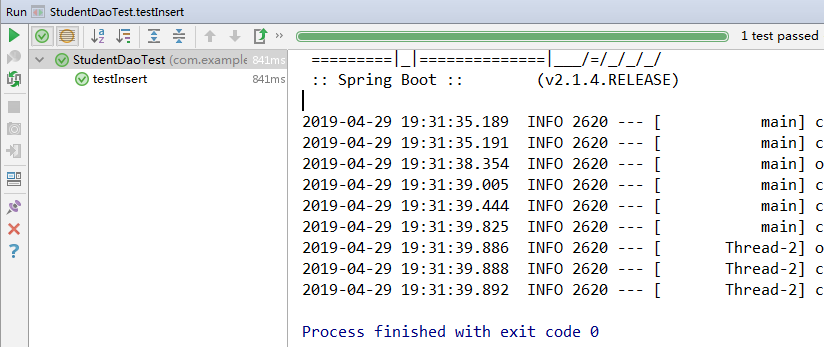
表中也插入了一条数据:
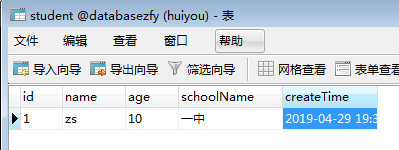
目录结构:

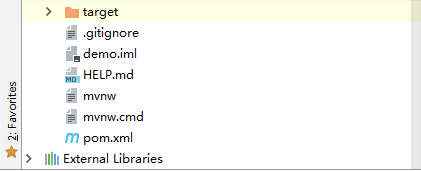
三、与JPA集成
JPA是Java Persistence API的简称,中文名Java持久层API,是JDK 5.0注解或XML描述对象-关系表的映射关系,并将运行期的实体对象持久化到数据库中。
现在我们开始讲解如何通过JPA的方式来实现数据库的操作。还是跟JdbcTemplate类似,首先,我们需要引入对应的starter:
<dependency>
<groupId>org.springframework.boot</groupId>
<artifactId>spring-boot-starter-data-jpa</artifactId>
</dependency>
然后我们需要对POJO类增加Entity的注解,并指定表名(如果不指定,默认的表名为student),然后需要指定表主键ID所在的get方法,这些都是JPA的知识,与Spring boot无关,如果不熟悉的话可以看下JPA的知识点,注意注解所在的包,别引错包。
@Entity
@Table(name = "student")
public class Student implements Serializable {
private static final long serialVersionUID = 5465872778586910807L; private String id;
private String name;
private String age;
private String schoolName;
private Date createTime; @Id
public String getId() {
return id;
}
.................................
.................................
}
最后,我们需要继承JpaRepository这个类,这里我们实现了两个查询方法,第一个是符合JPA命名规范的查询(方法名写的时候会有提示),JPA会自动帮我们完成查询语句的生成,另一种方式是我们自己实现JPQL(JPA支持的一种类SQL的查询),这里举例使用第一种的查询
public interface StudentRepository extends JpaRepository<Student,String>{
public Student findStudentById(String id);
}
JpaRepository<Student,String>中的参数表明实体和主键类型。
好了,我们可以再测试一下上面的代码:
@RunWith(SpringJUnit4ClassRunner.class)
@SpringBootTest(classes = DemoApplication.class)
public class StudentRepositoryTest {
@Autowired
private StudentRepository studentRepository; @Test
public void testQuery(){
Student studentById = studentRepository.findStudentById("1");
System.out.println(studentById);
}
}
测试结果:报错
Caused by: com.mysql.jdbc.exceptions.jdbc4.MySQLSyntaxErrorException: Unknown column 'student0_.create_time' in 'field list'
at sun.reflect.NativeConstructorAccessorImpl.newInstance0(Native Method)
at sun.reflect.NativeConstructorAccessorImpl.newInstance(NativeConstructorAccessorImpl.java:62)
at sun.reflect.DelegatingConstructorAccessorImpl.newInstance(DelegatingConstructorAccessorImpl.java:45)
at java.lang.reflect.Constructor.newInstance(Constructor.java:423)
at com.mysql.jdbc.Util.handleNewInstance(Util.java:377)
at com.mysql.jdbc.Util.getInstance(Util.java:360)
原因:类的属性,表字段命名是驼峰命名法(createTime),Spring data jpa 在操作表的时候,生成的sql语句中却是create_time, 表字段不对照,解决方法参见:jpa数据库表实体命名规则 Unknown column 'user0_.create_time' in 'field list',生成的sql语句时无修改命名,即在application.properties配置文件中加入
spring.jpa.hibernate.naming.physical-strategy=org.hibernate.boot.model.naming.PhysicalNamingStrategyStandardImpl
spring.datasource.url=jdbc:mysql://localhost:3306/databasezfy?useUnicode=true&characterEncoding=UTF-8&useSSL=false
spring.datasource.driverClassName=com.mysql.jdbc.Driver
spring.datasource.username=root
spring.datasource.password=123456 spring.jpa.hibernate.naming.physical-strategy=org.hibernate.boot.model.naming.PhysicalNamingStrategyStandardImpl
在测试一下:test passed

四、与MyBatis集成
最后,我们再看看如何通过MyBatis来实现数据库的访问。同样我们还是要引入starter:
<dependency>
<groupId>org.mybatis.spring.boot</groupId>
<artifactId>mybatis-spring-boot-starter</artifactId>
<version>1.1.1</version>
</dependency>
由于该starter不是spring boot官方提供的,所以版本号于Spring boot不一致,需要手动指定。
MyBatis一般可以通过XML或者注解的方式来指定操作数据库的SQL,个人比较偏向于XML,所以,本文中也只演示了通过XML的方式来访问数据库。首先,我们需要配置mapper的目录。我们在application.properties中进行配置:
spring.datasource.url=jdbc:mysql://localhost:3306/databasezfy?useUnicode=true&characterEncoding=UTF-8&useSSL=false
spring.datasource.driverClassName=com.mysql.jdbc.Driver
spring.datasource.username=root
spring.datasource.password=123456 mybatis.config-locations=mybatis/mybatis-config.xml
mybatis.mapper-locations=mybatis/mapper/*.xml
这里配置主要包括两个部分,一个是mybatis自身的一些配置,例如基本类型的别名,是否支持缓存。第二个是指定mapper文件的位置。这个配置也可以通过 Java configuration来实现,由于篇幅的问题,我这里就不详述了,有兴趣的朋友可以自己实现一下。
配置完后,我们先编写mapper对应的接口:
@Service
public interface StudentMapper {
public int insertStudent(Student student);
}
该接口暂时只定义了一个方法,即插入操作。这是一个接口,并且和JPA类似,可以不用实现类。接下来我们编写XML文件:
<?xml version="1.0" encoding="UTF-8"?>
<!DOCTYPE mapper PUBLIC "-//mybatis.org//DTD Mapper 3.0//EN"
"http://mybatis.org/dtd/mybatis-3-mapper.dtd">
<mapper namespace="com.example.demo.dao.StudentMapper">
<sql id="base_column">
id,name,age,schoolName,createTime
</sql> <insert id="insertStudent" parameterType="com.example.demo.entity.Student">
INSERT INTO
student(<include refid="base_column"/>)
VALUES
(#{id},#{name},#{age},#{schoolName},#{createTime})
</insert> </mapper>
好了,与MyBatis的集成也完成了,我们再测试一下:
@RunWith(SpringJUnit4ClassRunner.class)
@SpringBootTest(classes = DemoApplication.class)
public class StudentMapperTest { @Autowired
private StudentMapper studentMapper; @Test
public void testInsert() {
Student student = new Student();
student.setId("2");
student.setName("ls");
student.setAge("11");
student.setSchoolName("erzhong");
student.setCreateTime(new Date());
studentMapper.insertStudent(student);
}
}
测试一下,会发现报错
org.springframework.beans.factory.UnsatisfiedDependencyException: Error creating bean with name 'com.example.demo.dao.StudentMapperTest': Unsatisfied dependency expressed through field 'studentMapper'; nested exception is org.springframework.beans.factory.NoSuchBeanDefinitionException: No qualifying bean of type 'com.example.demo.dao.StudentMapper' available: expected at least 1 bean which qualifies as autowire candidate. Dependency annotations: {@org.springframework.beans.factory.annotation.Autowired(required=true)}
at org.springframework.beans.factory.annotation.AutowiredAnnotationBeanPostProcessor$AutowiredFieldElement.inject(AutowiredAnnotationBeanPostProcessor.java:596) ~[spring-beans-5.1.6.RELEASE.jar:5.1.6.RELEASE]
at org.springframework.beans.factory.annotation.InjectionMetadata.inject(InjectionMetadata.java:90) ~[spring-beans-5.1.6.RELEASE.jar:5.1.6.RELEASE]
No qualifying bean of type 'com.example.demo.dao.StudentMapper' available,也就是说StudentMapperTest中依赖的StudentMapper unavaliable,即找不到StudentMapper类。所以在启动DemoApplication需要扫描StudentMapper类,加上@MapperScan注解扫描j将*Mapper扫描进来。@MapperScan注解
@SpringBootApplication
@MapperScan("com.example.demo.dao")
public class DemoApplication { public static void main(String[] args) {
SpringApplication.run(DemoApplication.class, args);
} }
在测试一下:

插入成功:
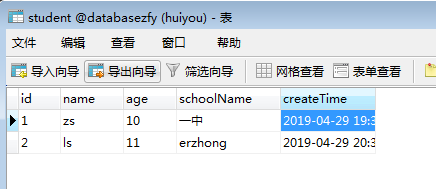
捋一下StudentMapperTest整个插入操作执行的过程:
①加载Application这个类,扫描com.example.demo.dao包下的所有Mapper
②这样就可以通过@Autowired注解引入StudentMapper,执行insertStudent方
③通过配置文件application.properties中的mybatis.mapper-locations=mybatis/mapper/*.xml定位到*.xml文件,最后通过nameSpace即StudentMapper所在的路径(com.example.demo.dao.StudentMapper)和SQL语句中的id即方法名(insertStudent)唯一标识对应的SQL语句。
附上目录结构:
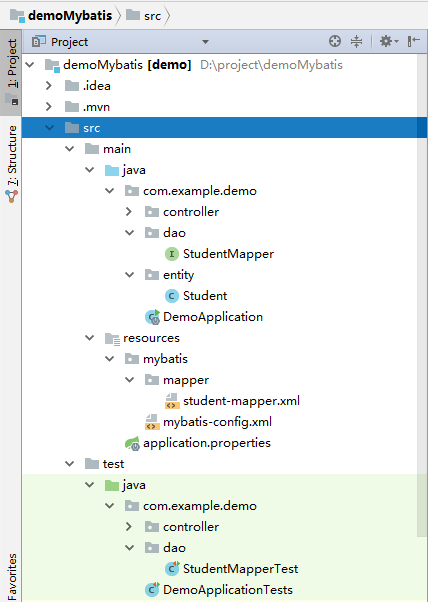
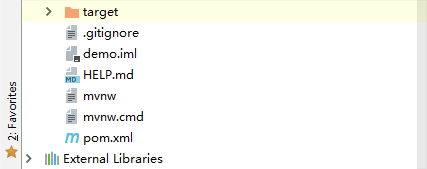
五、总结
本文演示Spring boot与JdbcTemplate、JPA以及MyBatis的集成,整体上来说配置都比较简单,以前做过相关配置的同学应该感觉比较明显,Spring boot确实在这方面给我们提供了很大的帮助。后续的文章中我们只会使用MyBatis这一种方式来进行数据库的操作。
参考资料:
Spring Boot(二):数据库操作的更多相关文章
- Spring Boot学习——数据库操作及事务管理
本文讲解使用Spring-Data-Jpa操作数据库. JPA定义了一系列对象持久化的标准. 一.在项目中使用Spring-Data-Jpa 1. 配置文件application.properties ...
- spring boot访问数据库
1. Spring JAP 基本使用说明: Spring boot 访问数据库基本上都是通过Spring JPA封装的Bean作为API的,Spring JPA 将访问数据库通过封装,只要你的类实现了 ...
- Spring Boot(二十):使用spring-boot-admin对spring-boot服务进行监控
Spring Boot(二十):使用spring-boot-admin对spring-boot服务进行监控 Spring Boot Actuator提供了对单个Spring Boot的监控,信息包含: ...
- Spring Boot 二十个注解
Spring Boot 二十个注解 占据无力拥有的东西是一种悲哀. Cold on the outside passionate on the insede. 背景:Spring Boot 注解的强大 ...
- Spring Boot中快速操作Mongodb
Spring Boot中快速操作Mongodb 在Spring Boot中集成Mongodb非常简单,只需要加入Mongodb的Starter包即可,代码如下: <dependency> ...
- Spring Boot MyBatis 数据库集群访问实现
Spring Boot MyBatis 数据库集群访问实现 本示例主要介绍了Spring Boot程序方式实现数据库集群访问,读库轮询方式实现负载均衡.阅读本示例前,建议你有AOP编程基础.mybat ...
- spring boot由浅入深(二)spring boot基本命令及操作
一 spring常见注解 @RestController和@RequestMapping说明: @RestController.这被称为一个构造型(stereotype)注解.它为阅读代码的人们提供建 ...
- spring boot(二):web综合开发
上篇文章介绍了Spring boot初级教程:spring boot(一):入门篇,方便大家快速入门.了解实践Spring boot特性:本篇文章接着上篇内容继续为大家介绍spring boot的其它 ...
- Spring boot实现数据库读写分离
背景 数据库配置主从之后,如何在代码层面实现读写分离? 用户自定义设置数据库路由 Spring boot提供了AbstractRoutingDataSource根据用户定义的规则选择当前的数据库,这样 ...
随机推荐
- 强化学习(十一) Prioritized Replay DQN
在强化学习(十)Double DQN (DDQN)中,我们讲到了DDQN使用两个Q网络,用当前Q网络计算最大Q值对应的动作,用目标Q网络计算这个最大动作对应的目标Q值,进而消除贪婪法带来的偏差.今天我 ...
- spring-boot-starter-actuator /info获取空信息
用了spring-boot-starter-actuator,在监控页面对应服务中显示空值,下面是正常情况下有的值 pom配置了 <build> <plugins> <p ...
- 【转载】SQL语句中Union和Union All的区别
在使用到SQL语句进行数据库查询的过程中,如果需要求两个数据集合的并集,一般会使用到联合查询关键字Union或者Union All,其实Union和Union All两者的使用有一定差别,查出来的数据 ...
- vs2017和vs2019专业版和企业版
步骤:打开vs2017,依次点击--->帮助----->注册产品 专业版: Professional: KBJFW-NXHK6-W4WJM-CRMQB-G3CDH 企业版: Enterpr ...
- Centos7上安装docker
Docker从1.13版本之后采用时间线的方式作为版本号,分为社区版CE和企业版EE. 社区版是免费提供给个人开发者和小型团体使用的,企业版会提供额外的收费服务,比如经过官方测试认证过的基础设施.容器 ...
- js转换时间戳-转换成 yyyy-MM-dd HH:mm:ss
比如:转换成 yyyy-MM-dd HH:mm:ss //时间戳转换方法 date:时间戳数字 function formatDate(date) { var date = new Date(date ...
- .net 笔试面试总结(3)
什么是Sql注入?如何避免Sql注入? 用户根据系统的程序构造非法的参数从而导致程序执行不是程序期望的恶意Sql语句. 使用参数化的Sql就可以避免Sql注入. 数据库三范式是什么? 第一范式:字段不 ...
- vue实例化
<!DOCTYPE html> <html lang="en"> <head> <meta charset="UTF-8&quo ...
- jsp内置对象-page对象
page对象代表jsp本身,只有在jsp页面才有效.page对象本质上是被转换后的Servlet,因此它可以调用任何被Servlet类所定义的方法. 项目ch05案例:创建HttpJSPPage类的对 ...
- 【土旦】vue项目中 使用 pako.js 解密 gzip加密字符串
前言 今天跟后台对接一个接口,接受到一个加密的值,说是通过gzip加密过的,然后就蒙蔽了, 赶紧上百度找了一下资料,通过一篇文章(原文在底部)发现有个js库可以解密,就下载轻松解密了 实现代码 pok ...
